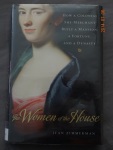Warner Library serves Tarrytown and Sleepy Hollow. Inter-Library Loan allows the borrowing of materials from other Westchester County libraries, thereby increasing the resources made available.
Title: Women of the House: How a Colonial She-Merchant built a Mansion, a Fortune, and a Dynasty
Publication Information: Orlando, Fla. : Harcourt, c2006 (1st ed.)
ISBN: 0-15-101065-X (i.e. 978-0-15-101065-3)
Library of Congress Classification: F122.1.P48
Dewey Decimal Classification: 974.7
Library of Congress Subject Headings:
Philipse, Margaret Hardenbroeck.
Philipse, Margaret Hardenbroeck–Family
Phillips family
Women merchants–New Netherland–Biography
New Netherland–Biography
New Netherland–Commerce–History
New Netherland–Social conditions
New York (State)–History–Colonial period, ca. 1600-1775–Biography
The world of New Netherland, the colony founded by the Dutch that would later become New York City, comes alive through the life of Margaret Hardenbroeck, an immigrant from the Netherlands who comes to the New World (at age 22) as an agent of her cousin, but who stays and becomes a merchant and a magnate in her own right.
The term “she-merchant” had a legal recognition in Dutch law. Margaret, like all women, could represent herself in a Dutch court of law, write her own will and bequeath her worldly goods to anyone she wished. The Dutch Reformed Church was quite progressive: it advocated for the education of men and women. Women were expected to be as literate as men. The Netherlands was a mercantile republic, meaning that the merchants ran the country. Women were allowed to represent themselves in any business adventures that they undertook.
The New Netherland colony is a perfect example of a “turning back of the clock,” which all minorities fear. It’s the taking away of privileges and rights earned over time by those in the least powerful positions. When the English conquered New Netherland in 1664, they agreed not to take any of the rights away from the Dutch that they had previously held under the former government. Almost immediately, this began to erode. Zimmerman discusses the various attempts by the British to limit the powers of the Dutch merchants, but what is even more alarming is how the she-merchants, as with all women, lost their rights as citizens. Under British law, a woman could only be represented in court by her father or her husband; Margaret found it increasingly difficult to undertake any business activity by herself. The old Dutch custom of women keeping their own names even after marriage was also abandoned. Women were no longer treated as partners in a marriage, but as their husbands’ chattel.
This loss extended to education as well. As Britain tightened the grip on the colony, the Dutch found it increasingly difficult to hire teachers to educate their children in the Dutch language, customs and law. Women were expected to be good wives and mothers; they had no reason to be educated. Thus, as the British eliminated the Dutch customs, women became uneducated, just as the British expected wives and mothers to be. They were taught how to darn socks and embroider and the other necessary skills a good wife and mother would expect to know, but to women like Margaret this was death.
Margaret married twice. First, she married Pieter Rudolphus de Vries. Margaret, at 22, married Pieter, 57, probably because she was already pregnant with their child. Maria was born, but she would never get to know her father, since Pieter died at 58 of an unknown ailment. Margaret then married Frederick Philipse, a carpenter who arrived 6 years before Margaret in New Amsterdam. Like Margaret, Frederick was on his way to creating a business empire. After swearing that Eva–the name Maria was adopted under–would be raised as his own child, Frederick was permitted to marry Margaret in the Dutch Reformed Church.
They had Philip, Adolph, Annetje, and Rombout as well as Eva. The Philipses expanded their trading empire as well as the lands that they owned. From Spuyten Duyvil Creek in the Bronx up to the Croton River in Westchester County, the Philipses carved out what would become known as Philipse Manor–or Philipsburg Manor. This huge track of land bordered the Hudson and Bronx Rivers. The Philipses had tenant farmers working on this land. They had manor houses in Yonkers, where the “lower mills” was located, and one in Sleepy Hollow, known as the “upper mills.” Both manor houses still survive as historic landmarks.
The Old Dutch Church, made famous in The Legend of Sleepy Hollow, was planned by Margaret but never built. Her successor Catherine, who married Frederick after her death, built the church. The bell, cast in Holland with the date 1685 and made for Margaret, still hangs in the belfry. Catherine and Frederick are buried in the church.
The book ends with the successors of Margaret, Catherine and Frederick leaving the new United States in 1783. The Philipses had supported the Crown during the Revolutionary War and paid for it. All their lands, the vast manor, was confiscated. Other Tories, such as the Van Cortlandts, were forgiven by the new nation, but none of these families had the best lands on the Hudson and in Westchester. The former Philipse Manor was divided up into parcels and sold off.
For anyone who enjoys learning about local colonial and Revolutionary history. An enjoyable, informative book. It had been selected by the Historical Society‘s book club.

